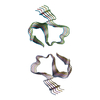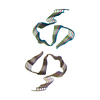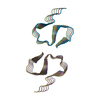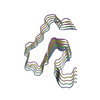+Search query
-Structure paper
| Title | Cryo-EM of Aβ fibrils from mouse models find tg-APP fibrils resemble those found in patients with sporadic Alzheimer's disease. |
|---|---|
| Journal, issue, pages | Nat Neurosci, Vol. 26, Issue 12, Page 2073-2080, Year 2023 |
| Publish date | Nov 16, 2023 |
 Authors Authors | Mara Zielinski / Fernanda S Peralta Reyes / Lothar Gremer / Sarah Schemmert / Benedikt Frieg / Luisa U Schäfer / Antje Willuweit / Lili Donner / Margitta Elvers / Lars N G Nilsson / Stina Syvänen / Dag Sehlin / Martin Ingelsson / Dieter Willbold / Gunnar F Schröder /     |
| PubMed Abstract | The use of transgenic mice displaying amyloid-β (Aβ) brain pathology has been essential for the preclinical assessment of new treatment strategies for Alzheimer's disease. However, the properties ...The use of transgenic mice displaying amyloid-β (Aβ) brain pathology has been essential for the preclinical assessment of new treatment strategies for Alzheimer's disease. However, the properties of Aβ in such mice have not been systematically compared to Aβ in the brains of patients with Alzheimer's disease. Here, we determined the structures of nine ex vivo Aβ fibrils from six different mouse models by cryogenic-electron microscopy. We found novel Aβ fibril structures in the APP/PS1, ARTE10 and tg-SwDI models, whereas the human type II filament fold was found in the ARTE10, tg-APP and APP23 models. The tg-APP mice showed an Aβ fibril whose structure resembles the human type I filament found in patients with sporadic Alzheimer's disease. A detailed assessment of the Aβ fibril structure is key to the selection of adequate mouse models for the preclinical development of novel plaque-targeting therapeutics and positron emission tomography imaging tracers in Alzheimer's disease. |
 External links External links |  Nat Neurosci / Nat Neurosci /  PubMed:37973869 / PubMed:37973869 /  PubMed Central PubMed Central |
| Methods | EM (helical sym.) |
| Resolution | 3.0 - 4.2 Å |
| Structure data | EMDB-16942, PDB-8ol2: EMDB-16944, PDB-8ol3: EMDB-16949, PDB-8ol5: EMDB-16952, PDB-8ol6: EMDB-16953, PDB-8ol7: EMDB-16957, PDB-8olg: EMDB-16959, PDB-8oln: EMDB-16960, PDB-8olo: EMDB-16961, PDB-8olq: |
| Source |
|
 Keywords Keywords | PROTEIN FIBRIL /  Amyloid fibril Amyloid fibril |
 Movie
Movie Controller
Controller Structure viewers
Structure viewers About Yorodumi Papers
About Yorodumi Papers























